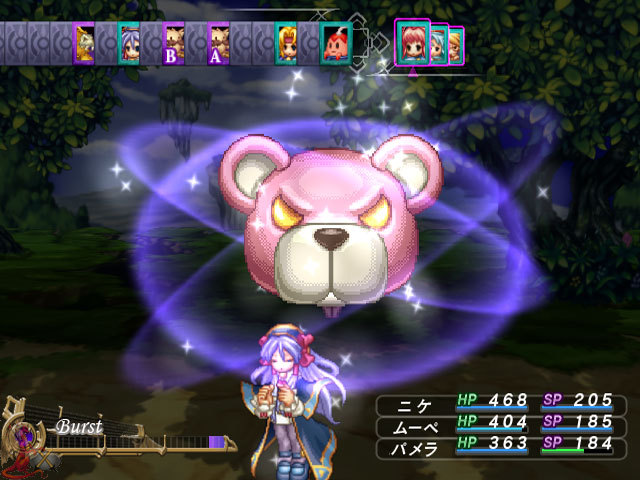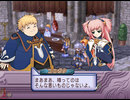|
|

|
PLATFORM
|
PS2
|
BATTLE SYSTEM
|

|
INTERACTION
|

|
ORIGINALITY
|

|
STORY
|

|
MUSIC & SOUND
|

|
VISUALS
|

|
CHALLENGE
|
Hard
|
COMPLETION TIME
|
20-40 Hours
|
|
OVERALL

|
+ Solid gameplay systems.
+ Character events add some depth to plot.
+ Decent music and graphics.
- Interface could've been much tighter.
- Plot is a bit too character-driven.
- Graphics are a bit choppy at times.
|
Click here for scoring definitions
|
|
|
Vayne Aurelius is a boy with little memory of his past or family who lives alone with his cat, Sulpher. One day, he is invited to attend the Al-Revis Academy, specializing in alchemy, by one of its teachers. At the school, Vayne makes several friends and begins to unravel the mystery of his past. Gust's Mana Khemia: Alchemists of Al-Revis, continues the company's flagship Atelier series, changing the franchise's alchemic formula with a mix of old elements from its predecessors and other RPGs, and a touch of new elements that ultimately make the title's adventures through academia quite enjoyable.
Mana Khemia is a very structured title, divided into several chapters, each beginning with a story event and then proceeding to allow the player to select a number of different classes to take, one at a time, in various subjects such as combat and alchemy. These classes typically have conditions to fulfill like killing certain enemies quickly or synthesizing certain items. After their completion, the player receives a grade from A to F and a certain amount of stamps depending upon how high their grade is. Each academic period requires players to acquire a certain amount of stamps with a certain number of classes, and if the player doesn't obtain the needed amount, they'll receive detention, where they have to perform additional tasks to advance the main storyline.
If players successfully complete the courses they take, they get "free time" in which they can wander the school and its outskirts as they please, take jobs for additional money, mess around with item synthesis, purchase items (though players can perform the latter two tasks before officially signing up for classes), and so forth. Advancing through such free time requires Vayne to talk with one of his allies to trigger a character event. In between periods of a chapter, moreover, the player can have characters "search" for bonus AP used for skill and stat advancement, synthesize items, or hunt in certain areas for items. After free time, the main storyline advances, with the player usually needing to trek a dungeon and fight a boss to proceed.
 Mmm...red chocolate.
Mmm...red chocolate.
|
|
Getting into battle involves slashing at blue or red slimes wandering dungeons. Blue slimes are weaker than the player's party, and die upon being slashed, typically yielding an item but nothing else. Running into blue slimes, or slashing/running into red slimes, conversely, triggers a battle, which follows the structure established in Atelier Iris 3, where a number of cards appear at the top of the screen indicating character and enemy turn order. Each character has a number of commands from which to choose, such as attacking normally, using SP-consuming skills, defending (with the player able to choose when the defending character's next turn will be), using one of dozens of different items, or escaping.
SP-consuming skills come in a number of varieties, such as "Double Up" skills that a character executes after a certain time, and "Time Effect" skills that place a number of icons on the card gauge, with that particular skill executing once one of its cards has reached the end of the turn gauge. The Burst Gauge from Atelier Iris 3 also returns, filling up as the player attacks the enemy; exploiting their weaknesses (with Vayne's Analyze skill, luckily, working permanently against each type of enemy) fills the gauge more quickly, sending the battle into Burst Mode, where all characters' attack power temporarily increases, and the player must fulfill a certain condition (such as using skills of a certain element) to fill a secondary gauge for a character to execute an ultra-powerful Finishing Burst against the enemy, ending Burst Mode (although Burst Mode can end before this if the player can't fulfill said condition).
Alongside the three characters participating in battle, three other characters form the player's reserve (with more than six playable characters acquired during the game), with the player able to swap them out, although doing so requires the swapped character to stay in reserve to "charge" before becoming swappable. However, there are other ways in which the player can swap characters; for instance, after a character attacks an enemy, the player can instantly swap the attacker with a reserve character, who too contributes an attack, in which case the player can have yet another reserve character drop in and attack. If a chain of three swaps (the maximum) in this method ends with Vayne, he will perform a powerful Variable Strike against the enemy. It is further possible to swap a weak character being attacked with a reserve character.
 Evil bear attack
Evil bear attack
|
|
Mana Khemia, moreover, handles death in combat differently than most other RPGs, depending upon the type of battle. If the player's party dies in a normal fight, they will be taken to the school infirmary with no penalty; conversely, death in a story battle will result in an unceremonious "Game Over" and trip back to the title screen. This particular installment, this reviewer should mention, is perhaps the most difficult of the Playstation 2 Atelier titles, with many boss fights often testing the player's resources, and in many instances being a matter of endurance, depending upon how many and what type of healing items and skills are available.
This installment, unlike its predecessors, does not feature a standard system of leveling up characters through experience acquired from combat. Instead, alchemy largely drives character advancement, with the synthesis of new types of items at the player's workshop or the nearby forge opening up new areas in each character's Grow Book, where the player can spend AP gained from battle (alongside money and occasional items) to increase stats and acquire new abilities. Overall, the game's systems work nicely together, with little to complain about aside from the mentioned issue with swapping characters normally in battle and the occasional sluggishness of normal fights (though these, to a large extent, are mercifully optional).
The interface and controls of Mana Khemia, however, could have been tighter. Granted, the game's structured nature takes the guesswork out of finding out how to advance the main storyline, although item synthesis can be time-consuming (the need to synthesize consumable items/materials and equipment at different facilities makes things worse), and a convenience introduced in another Gust title, Ar tonelico, which instantly led players to synthesizable items needed to create selected items, would have been of great asset here. The game would have also seriously benefited from an "equip best" feature, since equipping new weapons, armor, and accessories can also be tedious given the number of stats to consider when doing so. Ultimately, Mana Khemia could have been more user-friendly.
The latest addition to the Atelier series is largely a combination of elements from previous installments, such as alchemy and the structure of combat from Atelier Iris 3, and elements from other RPGs, with the Grow Book system somewhat resembling the Sphere Grid system from Final Fantasy X, and the game simulating school much akin to Persona 3. However, Mana Khemia does have unique takes on these systems, with the need to synthesize items to increase stats and obtain skills, alongside the system of taking classes, getting grades, detention, and so forth, being inventive, and overall, this installment remains fresh in its own right.
 "First things first! Where's your crapper?"
"First things first! Where's your crapper?"
|
|
The mystery of Vayne's past largely drives Mana Khemia's story, alongside the character events needed to advance “free time” periods, which contribute decent depth to his allies, and can even affect the game's ending. Conflict at best plays a minimal part in the plot, understandable given the game's academic nature. All in all, the story doesn't excel, but still has many things going for it, such as decent characters and a sense of humor at times.
Mana Khemia features a musical style similar to its predecessors, with most tracks having a "bouncy" feel, and battle themes being energetic. Most of the tracks are enjoyable, such as the vocalized Japanese theme songs and the normal battle theme during the latter portion of the game, with a number of unusual pieces as well, such as Muppy's theme, which sounds like 8-bit Egyptian music with someone rapping in the background. Voice acting also occasionally narrates cutscenes, its quality being hit-or-miss for the most part; some voices are okay, although some are somewhat poor, with Flay for instance sounding like a dumb superhero. Despite this, the game's aural package is well more than satisfactory.
Although Gust's games have traditionally featured two-dimensional visuals, this installment somewhat changes course in this area. Character and monster sprites, alongside static character portraits during cutscenes, remain more or less 2-D, although school and dungeon scenery is largely three-dimensional, yet strangely looks 2-D at times when not in motion, with a decent scroll during navigation, at that. Granted, slowdown can occur during dungeon treks when numerous sprites, whether Vayne, monsters, or floating icons indicating gathering points, clog the screen, and in combat, as well, with a little choppiness at points. Still, Mana Khemia is by no means an ugly game, and is very easy on the eyes, despite some technical hiccups.
Finally, the game can be short or long, depending upon how much time the player devotes to alchemy and completely mapping all the dungeons; breezing straightforwardly through the game can take as little as thirty hours, although seeing through these sidequests, not to mention the replay mode, can drastically increment playing time.
Overall, Mana Khemia: Alchemists of Al-Revis in many respects takes the Atelier franchise in a different direction, what with a revamp of its systems combining old and new elements in and out of the series, and does so successfully. The gameplay for the most part excels, although there are certainly a number of areas, such as the interface and controls, which could have easily been better. The story doesn't shine, either, but does have a charm to it, as do the music and graphics, despite some minor imperfections. In the end, Mana Khemia revitalizes a series that was becoming somewhat stale, sure to satisfy its established fans and perhaps being a decent entry point for those ill-learned in the ways of alchemy.
Review Archives
|









